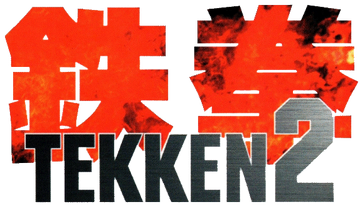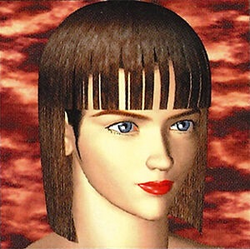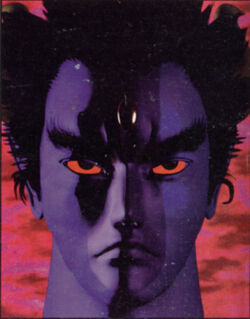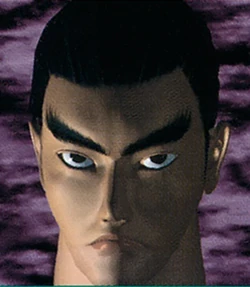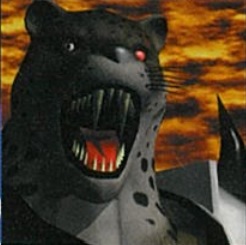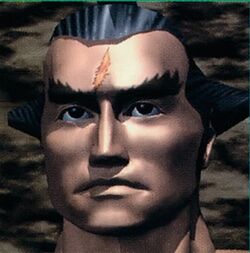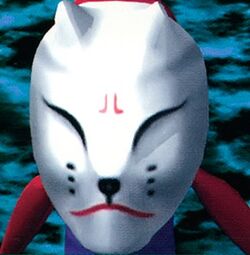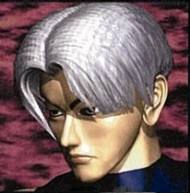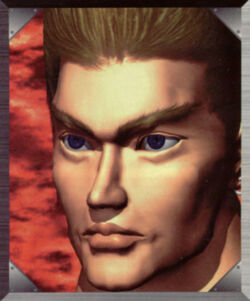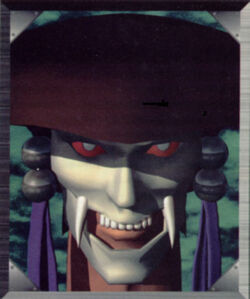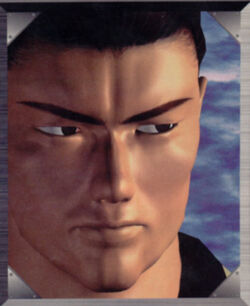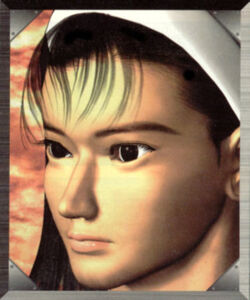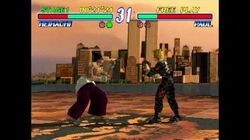Tekken 2 (鉄拳2, Tekken Tsū?, lit. Iron Fist 2) is the second installment in the Tekken fighting game series. The game was first released in arcades in 1995, and later released for the PlayStation in 1996. It was included in the Arcade History mode of Tekken 5, released in 2005 for the PlayStation 2, and was later released in 2007 for the PlayStation 3 and PlayStation Portable via the PlayStation Network. Mobile phone versions were also developed and released in 2006 and 2008, as well as a version for the Zeebo in 2009. Tekken 2 made various improvements over its predecessor in terms of graphics and features, and the PlayStation port included several new game modes. It became one of the best-selling games of the early PlayStation era, later eclipsed by its successor Tekken 3.
Story
Two years have passed since Kazuya Mishima won the first King of Iron Fist Tournament[1] and threw his defeated father, Heihachi Mishima, off of a cliff, presumably to his death.[2] Now the owner of the Mishima Zaibatsu, Kazuya chooses to hold a second tournament to mark another step on his path to domination, even as rumors that he has made a deal with the devil begin to circulate.
During the course of the tournament, Kazuya meets the competitor Jun Kazama, who he views as mysterious and without fear. Later, he is shocked to discover that Heihachi survived being thrown from a cliff two years prior, and has entered the tournament.[3]
Heihachi defeats Kazuya in the final round of the tournament. He takes Kazuya’s unconscious body to an active volcano and tosses him in.[4] With Kazuya gone, Heihachi reclaims the Mishima Zaibatsu.
Gameplay
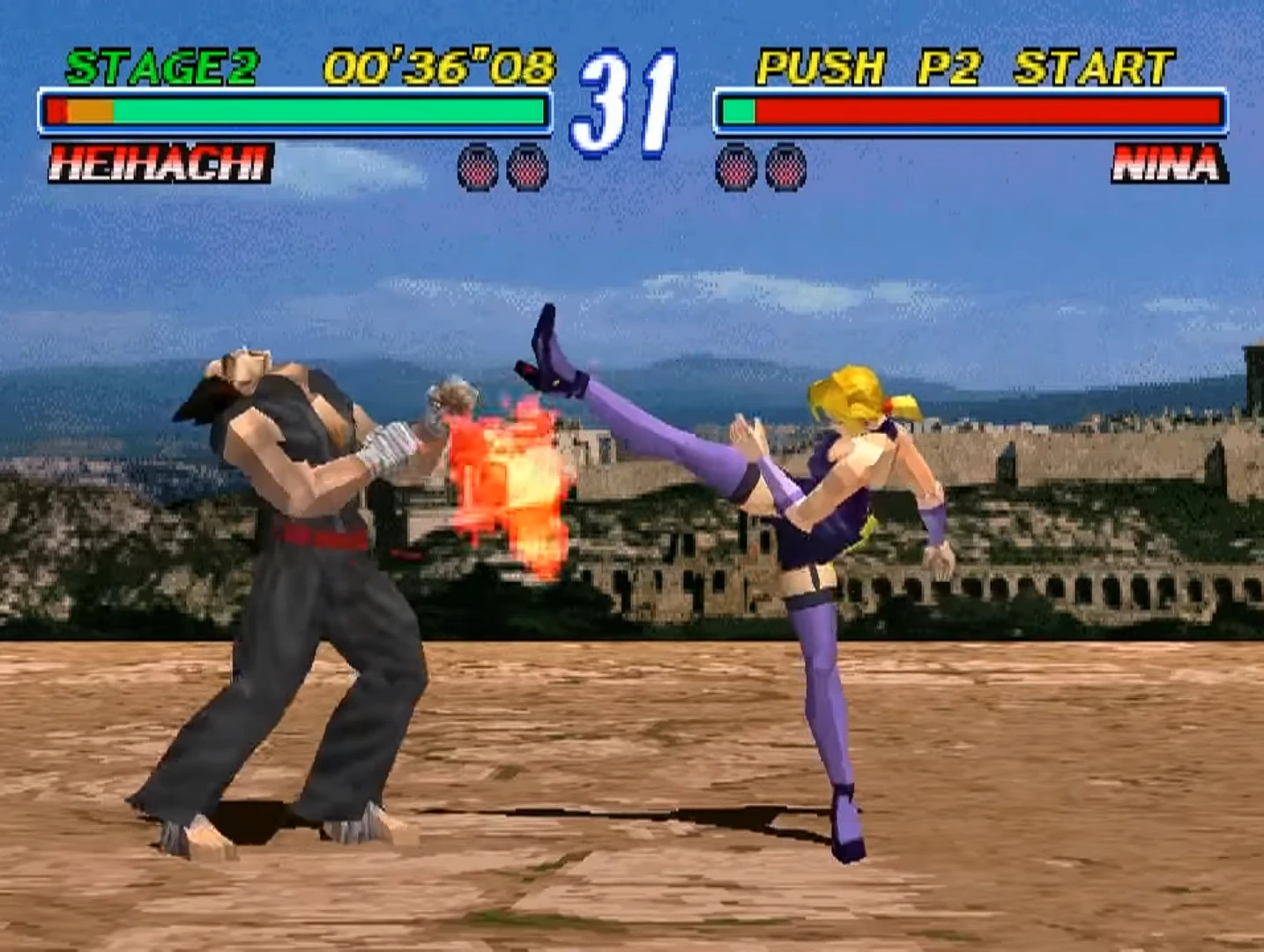
The gameplay in Tekken 2 is much like its predecessor, but improves on almost every attribute. It still features an infinite playing field, and uses the same fighting system that utilizes four buttons: left punch, right punch, left kick, and right kick. It continues to use 2D backgrounds in its stages albeit now more detailed and occasionally moving during battle. Distinct additions included sidestepping and attack reversals for some characters, back throws, and chain-throws, while tackles were modified to inflict more damage when running from a greater distance. The number of moves and combos has been doubled compared to its predecessor. Tekken 2 also had lighting effects impressive for its time, making some arenas look remarkable. Characters still looked blocky but with a noticeable polygon improvement to give them a more polished look. Additionally, the heads of fighters could now move during battle. Some technical fixes were also made by Namco.
Tekken 2 went through three distinct revisions. The initial arcade release, denoted as Ver.A in the test mode menu, was more similar to the first game and lacked polish, with some characters being significantly overpowered while others such as Kuma were lacking updated moves to set them apart from the previous game aside from a generic back throw. An update was released a month later, with the arcade version now displaying a Ver.B logo on the title screen. Tekken 2 Ver.B featured bug fixes, damage balancing, block stun recovery, an improved juggle system, several new moves and modified AI. A second minor update for the arcades, still called Tekken 2 Ver.B on the title screen but labeled Ver.C (or Ver.D) in the test menu and on a sticker on the arcade PCB, enables all hidden characters from the beginning rather than unlocking them through Time Release, and the hidden character cheat codes are disabled, having been made redundant. The Arcade History port is based on this updated version. The third and final revision was the PlayStation home version, which featured all of the Tekken 2 Ver.B changes plus a few bug fixes and modified AI once again.
Improving upon its predecessor, the home version of Tekken 2 introduced new the Team Battle, Time Attack Mode, Survival Mode, and Practice Mode alongside the previous game's Versus Mode. Additionally, the first game's Test Mode was now renamed Options Mode. Tekken 2 also introduced the option of auto-saving data to the Memory Card.
Moves
List of moves by character that can be performed in Tekken 2.
See: Tekken Move 2 Lists
Characters
Returning characters
New characters
Cameos
- Doctor Bosconovitch - in Yoshimitsu's ending
- Jane - in home console intro and Jack-2's ending
Unlockable characters
| Character | Condition to unlock |
|---|---|
| Anna Williams | Beat Arcade Mode with Nina Williams. |
| Armor King | Beat Arcade Mode with King. |
| Baek Doo San | Beat Arcade Mode with Marshall Law. |
| Bruce Irvin | Beat Arcade Mode with Lei Wulong. |
| Ganryu | Beat Arcade Mode with Michelle Chang. |
| Kuma | Beat Arcade Mode with Paul Phoenix. |
| Kunimitsu | Beat Arcade Mode with Yoshimitsu. |
| Lee Chaolan | Beat Arcade Mode with Heihachi Mishima. |
| Prototype Jack | Beat Arcade Mode with Jack-2. |
| Wang Jinrei | Beat Arcade Mode with Jun Kazama. |
| Kazuya Mishima | Beat Arcade Mode with any sub-boss after unlocking all of them. |
| Angel / Devil | Beat Arcade Mode with Kazuya Mishima. |
| Alex / Roger | Beat Stage 3 of Arcade Mode with a GREAT (5% or less health), then proceed to defeat Roger or Alex in Stage 4. |
Secret modes
| Mode | Conditions |
|---|---|
| Sky Mode | Unlock all characters and hold Select + Up when selecting a character until the fight actually begins |
| Wireframe Mode | Unlock all characters and hold L1 + L2 when selecting a character until the fight actually begins |
| Big Head Mode | Hold Select until when selecting a character until the fight actually begins |
Stages

(Jack-2)

(Nina Williams)

(Kunimitsu)

(Kazuya Mishima)

(Marshall Law)

(Lei Wulong)

(Lee Chaolan)

(Prototype Jack)

(Paul Phoenix)

(Heihachi Mishima)

(Wang Jinrei)

(Michelle Chang)

(Roger)

(King)

(Bruce Irvin)

(Kuma / Alex)

(Baek Doo San)

(Ganryu)

(Devil / Angel)

(Jun Kazama)

(Armor King)

(Yoshimitsu)

(Anna Williams)
Music
Tekken 2 had four soundtracks released: Namco Game Sound Express VOL.26 Tekken 2 (arcade), Tekken 2 Strike Fighting Vol.1, Tekken 2 Strike Fighting Vol.2 (console) and Tekken 2 Strike Arranges (remixes).
Voice cast
| Actor | Character/s |
|---|---|
| Banjō Ginga |
|
| Katsuhiro Harada |
|
| Lynn Harris |
|
| Shiho Kikuchi |
|
| Scott McCulloch |
|
| Takashi Nagasako |
|
| Jōji Nakata |
|
| Tamio Ōki |
|
| Nozomu Sasaki |
|
| Kaneto Shiozawa |
|
| Yumi Tōma |
|
| Wataru Takagi |
|
Gallery
Videos
Trivia
- This is the only game in the series where the arcade intro has the option of remixed music.
- This is the only game to not have a unique BGM for the Continue screen. Once the player is defeated, the BGM of the stage they were defeated in will keep on playing as the announcer counts down.
- The existence of Kazumi Mishima (Heihachi Mishima's wife) was alluded to for the first time in Tekken 2; ("Heihachi and Kazumi") can be seen carved into the floor of Heihachi's Pagoda Temple stage, in which their names are written in the style of Aiaigasa (a romantic expression to show love between couples).
- The floor carving was later seen in the very first trailer of Tekken 7 (where Kazumi made her canonical debut).
- Popular landmarks can be seen in some stages, for example - A destroyed (or partially buried) Big Ben can be seen in Prototype Jack's stage, and Stonehenge is visible in Jun Kazama's stage.
- This is the first game in the series to be a sponsor for a professional combat sport. Tekken 2 was a sponsor of WWF's "Monday Night Raw" in 1996.
- With a total of 23 stages, Tekken 2 had the highest number of stages in the series until Tekken 6's 61. It also had more stages than Tekken 7 until that game's Season 2 update.
- Close up images of the sub-boss and final boss (Kazuya Mishima and Devil) are used as the background of the pre-fight loading screen. This would later be used again in Tekken 6, showing Kazuya's son Jin Kazama and Azazel before their respective fights.
- The final part of the intro in which the screen shows Heihachi's face and then moves up towards the sky, eventually showing the game's logo, would later be mimicked in Tekken 5: Dark Resurrection.
- All characters from the previous game return in Tekken 2, with the exception of Jack who was replaced with Jack-2.
- In Heihachi's ending in which he throws his son into the volcano, Kazuya is clearly seen wearing his purple tuxedo. In Tekken 4, this scene is replicated only Kazuya is now wearing his white pants instead.
- In Practice Mode, if the player's character is left standing idle for a few moments, a thought bubble will appear above their head with a random image, such as fruit, Pac-Man or the Pac-Man ghosts, inside. If the player leaves Practice Mode paused for a long time, a countdown will start and the game will eventually return to the title screen.
- Once all 25 characters are unlocked, the Tekken 2 logo on the title screen will contain an image of Kazuya Mishima's face.
- The arcade version, once all characters are unlocked, states that only 23 characters are selectable rather than 25, as it doesn't distinguish Alex and Angel as separate characters. Any records set by Alex and Angel are credited to Roger and Devil respectively.
- In the arcade version of Tekken 2, the announcer does not say 'Devil' or 'Angel' when either character is selected. Additionally, Devil and Angel have no voice clips; Devil simply uses Kazuya's voice whereas Angel is completely silent (except for the KO yell, which is Kazuya's).
- Kazuya's boss outfit is not selectable in the arcade version.
- The Japanese PlayStation version has a Theater Mode, a feature that overseas fans wouldn't have until Tekken 3.
- If a memory card with completed Tekken 2 save data is inserted when playing Tekken 3 (with theater mode unlocked), the endings for Tekken 2 can be viewed and the game's soundtrack played; this also works for the original Tekken.
- The word "replay" now flashes.
- If a character is selected when holding the select button, he/she will become much larger and have a high-pitched voice. The size change can be done twice, however, the character's physical size and reach are unaffected, despite their appearance. For example, Yoshimitsu's sword still has the same range even though it is much larger. To disable the cheat, the battle must be lost and a different costume or character must be selected.
- If a character is selected when holding both Select and Up, he/she will have the above effects, and also bounce higher when juggled. A sound is heard upon loading the stage if this cheat is enabled.
- If L1 and L2 are held before the first stage, the game will enter a first-person wireframe mode, similar to Nintendo's Punch-Out!!.
- The inputs for the above effects are hidden in the PlayStation (PAL) version's instruction book, disguised in a stylized font. Text written down the sides of various opposing pages read "Hold Select to super-deform" and "Hold L1 and L2 for close-up action" respectively. The text is always in English, regardless of the language section. Additionally, text in the same font on the back of the game's case reads "Indisputably the greatest beat 'em up of its generation: Tekken 2, unparalleled genius.".
- In the records area, positions beyond the number 20 are displayed erroneously as 21th, 22th, and 23rd. This was fixed when Namco released the Western versions of Tekken 3 (the Japanese PlayStation version of Tekken 3 still displays 21th).
- King's and Kuma's icons, as well as their character select portraits, are actually renders from the first game. Their official Tekken 2 CG images are much more realistic than those from the previous game.
- The original arcade release of Tekken 2 (denoted as Ver.A in the test menu) has a few moves missing compared to later versions and ports, whilst other moves have different notations. Additionally, most throws lack sound effects of the opponent being hurt, much like that of the previous game. The PlayStation version, as well as the Tekken 5 Arcade History version, are based on Tekken 2 Ver.B (with the latter retaining the Ver.B logo on the title screen).
- The most notable difference between the AI in the arcade versions is that the Ver.A AI favors combos and string hits, whereas the Ver.B AI favors small pokes and throws, and blocks much more. The PlayStation version has similar AI to Ver.A, however, it also differs slightly from the arcade. Some examples are:
- The CPU will always jump an unblockable shoulder charge in the arcade version, yet in the PlayStation port, they fall for it.
- The CPU will always block the first half of the Frankensteiner move in the arcade version, but they will run straight into it in the PlayStation port, taking damage from both the hit and the throw.
- In the arcade version, the player can defeat the CPU with a Jack character or Kuma by sitting down and punching, but in the PlayStation port, the CPU will always block it or knock the player over.
- In Ver.A, Kazuya spams Dragon Uppercuts and Demon God Fists while Devil spams lasers, whereas in Ver.B, both Kazuya and Devil spam throws and rising kicks.
- In Ver.A, Lei will spam his Beating Kick combos, whereas in Ver.B he will spam his Hook Punch to Spinning Back Blow, leaving him open to back throws.
- In Ver.B, being extremely close to a downed opponent will cause the CPU to roll to the side, whereas in Ver.A and on the PlayStation, the CPU will almost always stand straight up and/or kick without rolling. Breaking the Ver.B AI like this can easily lead to sub-3-minute time records as it only takes the CPU to be knocked over and to counter their rising kick with a launcher or a powerful attack like a Phoenix Smasher or Megaton Blast which drains three quarters of their health on counter hit.
- In Ver.A, a high-level CPU will break a basic throw immediately, whereas in Ver.B and on the PlayStation (on Medium or Hard difficulty, or high-level Survival mode), they will break the throw about ten frames after it connects.
- In Ver.A, the CPU will fall for most command throws (especially while attempting a running tackle), however in Ver.B a high-level CPU will almost always crouch as soon as the throw is initiated, even if they are nowhere near the player.
- In the arcade version, when defeating an opponent with Heihachi's Neck Breaker, Heihachi will not say anything when the opponent's neck cracks as it is cut off by the announcer. The sound does play in the replay, however.
- The majority of sound effects were remade for the PlayStation version, along with the announcer's voice. The PlayStation version makes heavy use of a reverb effect for the announcer's voice and KO yells; the effect is in the sound files themselves and is not controlled by software, unlike the arcade version or in Tekken 3.
- Nina's high-damage hurt sound was replaced with a different yell.
- Anna's voice is at a higher pitch than Nina's, and has new clips for her hurt and KO sounds.
- Jun actually has two low-damage hurt sounds (plus her high-damage sound) in the arcade version, with either sound being used depending on her opponent, however the PlayStation version only has the lower-pitched sound. The extra sound clip returns in Tekken Tag Tournament.
- Kunimitsu's knife slash has a unique sound instead of using Yoshimitsu's sword slash.
- Jack-2 is missing his "raaaah!" yell, which was coincidentally also missing from Jack's sound clips in the home version of Tekken (strangely, in that game it was used in place of P.Jack's yell, with P.Jack missing the other yell instead).
- Devil and Angel received new voices. Devil's voice is still based on Kazuya's however it is played at two slightly different pitches, a similar effect to that used for Jinpachi Mishima in Tekken 5. Angel's voice is unique to this port and was not used in any other game (oddly, Angel used Nina's Tekken 1 voice in Tekken Tag Tournament).
- Devil and Angel make unique sounds while flying. On the arcade version, the sounds were a generic whoosh.
- Kuma and Roger both have an additional attack sound.
- More bone-cracking sounds, most notably during King's Figure Four Leg Lock.
- Most of the updated PlayStation sound effects were also used in the Tekken 5 Arcade History port, however the custom sound effects exclusive to the PlayStation version are not used, for example Angel once again fights silently (aside from Kazuya's KO yell) and Kunimitsu's knife sounds are Yoshimitsu's sword again. Sound effects recorded from the arcade version are slightly louder than those from the PlayStation version.
- The original arcade announcer's voice remains, complete with the "Good morning!" start-up clip. The PlayStation announcer is however used for the character's names.
- Jack-2's "raaaah!" yell which was absent from the PlayStation version has been re-added.
- Nina's updated voice is retained however, and is also used for Anna since both characters shared sound clips in the arcade version.
- Lei's and Kunimitsu's KO yells are that of the arcade version rather than the PlayStation version, as evidenced by the loudness and lack of reverb.
- Heihachi's KO yell is not played when he is defeated. Instead, his "huurgh" attacking sound is heard. This is a bug where the game program simply calls the wrong sound effect (the port of Tekken 3 has even more sound bugs); the sound is actually on the disc.
- Occasionally, one of King's and/or Armor King's roars occasionally plays at a much lower pitch than intended, most notably during the Giant Swing.
- In the PlayStation (PAL) version's instruction book, Jun Kazama's bio references Wang Jinrei, with his given name incorrectly spelled as 'Jinfrey' in the English, French, German, Italian, and Dutch sections, and 'Junfrey' in the Spanish section.
- In the PlayStation version, if only one controller is connected, the screen will say CREDIT 0 / INSERT COIN on the disconnected side. If both controllers are disconnected, the game will also display INSERT COIN on the title screen.
- Pictures of all the characters from the roster in this game are found in the "Tekken 2 Retro Series", excluding Heihachi Mishima and Prototype Jack. Paul Phoenix has two pictures, one for the body with arms, and the other one with his head.
- Michelle Chang's name is missing a lowercase "g" at the end of her surname in the Tekken 3 theater mode with the Tekken 2 disc inserted.
- The lineup of the initially available characters on the character select screen is different to the first Tekken, with Jun and Lei added at either end, and Heihachi replacing Kazuya.
- The announcer now uses all the characters' names, including Devil, Kuma, Armor King, Ganryu, Anna Williams, Kunimitsu, and Prototype Jack, whose names were not announced in the first Tekken game.
- The Tekken 2 cover art appears as a poster in the arcade in the Digimon games Digimon Story: Cyber Sleuth and Digimon Story: Cyber Sleuth – Hacker's Memory.
- Unauthorized bootleg versions of Tekken 2 were made (likely by Gamtec from Taiwan) for the Super Famicom/SNES and for the Sega Genesis/Mega Drive (called Tekken Special), and one for the Famicom/NES (by Hummer Team).
- A fully 3D mobile port was released in 2006 by NTT DoCoMo for FOMA 903i series phones in Japan.[5] Various other mobile ports of games including Monster Hunter and Street Fighter were also released as "Mega i-appli" applications.[6] The game was later also released for the Yahoo! Keitai distribution platform of SoftBank.
- Another mobile port of Tekken 2 was released in 2008 in the United States for Verizon Wireless cell phones (archived link). This one also remains faithful to the original 3D game.
- A version for the Zeebo console was also released.
- In Tekken: Bloodline first episode, Jin can be heard playing Tekken 2 on a handheld gaming system.
- Korean versions of the arcade board for Tekken 2 along with Tekken 2 posters, featured Baek Doo San on the front instead of Jun Kazama, at the request of the Korean distributors of the game.[7]
See Also
External Links
References
- ^ ‘’Tekken 2’’ Manual, p.4.
- ^ Tekken - Kazuya Mishima Ending (Remastered in 1080p using AI Machine Learning), YouTube
- ^ Tekken 6 - The Story of the Mishimas, YouTube
- ^ Tekken 2 - Heihachi Mishima Ending, YouTube
- ^ メガiアプリ版の鉄拳2はこんな感じ - YouTube
- ^ https://gigazine.net/gsc_news/en/20060915_foma_903i
- ^ See Harada's tweet concerning this, and the quote retweeted image of a Korean Tekken 2 poster.
